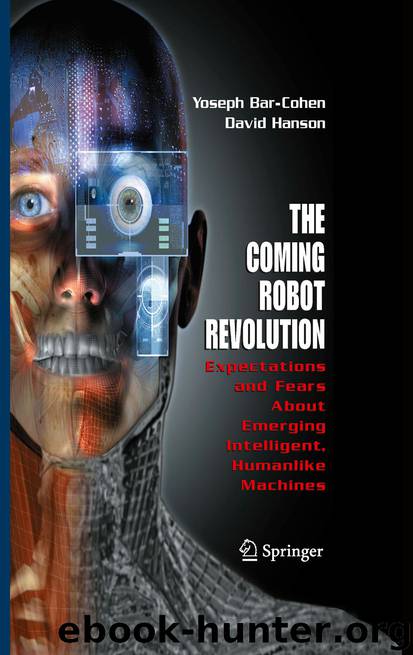The Coming Robot Revolution by David Hanson & Yoseph Bar-Cohen

Author:David Hanson & Yoseph Bar-Cohen
Language: eng
Format: epub
Publisher: Springer New York, New York, NY
The improvements in developing prosthetics have been enormous, and some of the disabled are now able to walk or run as good as or even better than humans with natural legs. An example that highlights the progress in the development of prosthetics is Oscar Pistorius, a South African with two prosthetic legs who sought to participate as a runner in the 2008 Olympics games in China. Initially, his request was turned down, because he was considered to have a competitive advantage. In rejecting his request to run, the International Association of Athletics Federations (IAAF) made the following statement: “An athlete using this prosthetic blade has a demonstrable mechanical advantage when compared to someone not using the blade.” This decision was reversed on May 16, 2008, after an appeal that was submitted to the Court of Arbitration for Sport (CAS), which is the sport's highest tribunal. In overturning the ban imposed by IAAF, CAS unanimously ruled that this 21-year-old South African was eligible to race against able-bodied athletes. In deciding to overturn the ban it was stated that (based on tests conducted by a team led by MIT) IAAF failed to prove that running blades give an advantage over the natural legs of able-bodied athletes. Unfortunately, Oscar Pistorius ended up not participating in the 2008 Olympics in China. In mid-July 2008 the track and field body of South Africa confirmed that he had not made the requirements for their 400 m relay team. Although Oscar Pistorius did not participate in the Olympic competition, the fact that he was given the opportunity to compete against runners with natural legs suggests a major milestone in the performance of prosthetics today.
In an effort to take advantage of the progress made in the area of prosthetics and support disabled soldiers, DARPA initiated the program called “Revolutionizing Prosthetics.” Specifically, the objective of this program is to develop a smart prosthetic hand that can operate and feel as good as real limbs. Thanks to this program we now have smart prosthetic hands and arms that match quite well the appearance and functions of a real human hand. Photos of such hands are shown in Figures 4.8 and 4.9 . The hand that is shown in Figure 4.9 is activated by movement of muscles in the healthy section of this soldier’s right arm. The capability of a full arm is shown in Figure 4.10 , where a prototype was used to support reading a book just the way a human hand can do. Another arm that was developed under the DARPA’s Revolutionizing Prosthetics program is the one shown in Figure 4.11 ; it is mounted on a user and is operating a drill. The prosthetic hand of this arm is controlled via a joystick worn on the healthy section of the severed arm. Since there are a limited number of movements that can be produced by the user’s hand, the raising and lowering of the prosthetic arm is done by mirroring the movements of the user’s tow using a related set of sensors.
Download
This site does not store any files on its server. We only index and link to content provided by other sites. Please contact the content providers to delete copyright contents if any and email us, we'll remove relevant links or contents immediately.
Algorithms of the Intelligent Web by Haralambos Marmanis;Dmitry Babenko(8522)
Test-Driven Development with Java by Alan Mellor(7427)
Data Augmentation with Python by Duc Haba(7317)
Principles of Data Fabric by Sonia Mezzetta(7065)
Learn Blender Simulations the Right Way by Stephen Pearson(7006)
Microservices with Spring Boot 3 and Spring Cloud by Magnus Larsson(6825)
RPA Solution Architect's Handbook by Sachin Sahgal(6234)
Hadoop in Practice by Alex Holmes(6032)
The Infinite Retina by Robert Scoble Irena Cronin(5935)
Jquery UI in Action : Master the concepts Of Jquery UI: A Step By Step Approach by ANMOL GOYAL(5873)
Big Data Analysis with Python by Ivan Marin(5732)
Life 3.0: Being Human in the Age of Artificial Intelligence by Tegmark Max(5404)
Pretrain Vision and Large Language Models in Python by Emily Webber(4693)
Infrastructure as Code for Beginners by Russ McKendrick(4471)
WordPress Plugin Development Cookbook by Yannick Lefebvre(4204)
Functional Programming in JavaScript by Mantyla Dan(4124)
The Age of Surveillance Capitalism by Shoshana Zuboff(4118)
Embracing Microservices Design by Ovais Mehboob Ahmed Khan Nabil Siddiqui and Timothy Oleson(3995)
Applied Machine Learning for Healthcare and Life Sciences Using AWS by Ujjwal Ratan(3971)
